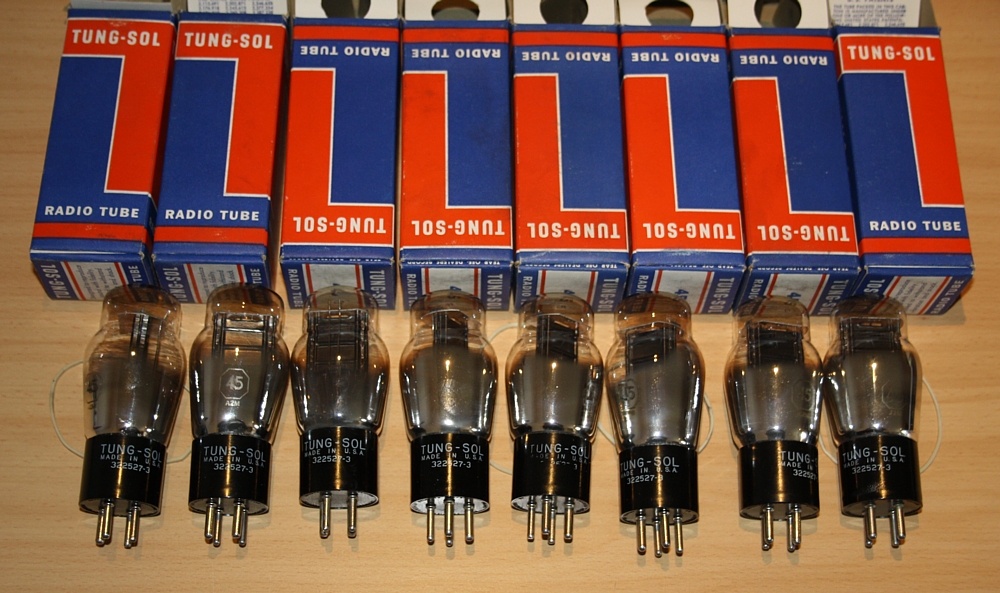Tung Sol NOS 45, Original box

Such a find, I have only once in 15 years.
All tube dealers know it. 45 can be found, but the problem is always the quality. Some people match tubes with a Hickok. This is fine with me, as long as you understand, the Hickok test result is an indication for the remaining lifetime, and has nothing to do with matching.
TESTING OF THE 45 TUBES1) Burn in.
If a tube will auto bias directly at 36mA, the original burn in is still functional. However, burn it begins to disappear after many years of storage. So when a tube is too low, it is either at the end of life, or perhaps it needs simply a new burn in. So the tube must always be burned at maximum dissipation, until it draws appr 36mA under normal conditions. After this, final testing can be done.
2) Grid current.
The 45 is a tube with a relatively small anode, small internal spacing, and not having a gold grid. The 45 gets incredible hot locally. So it is normal, these show some small grid current, and the only safe way to test for this, is with an analog uA meter in series with the grid, and then heat up the tube at maximum dissipation. Then, some grid current always can be observed after 2...4 Minutes. (This is what I do). This requires a 10uA full scale meter. There seems to be no historical information about this, but from testing many used and NOS tubes, I have concluded, a good 45 tube has maximum 1uA grid current under maximum dissipation, after thermal stability. At or below this value, the tube is good. When you are above, they will still work, but sure a tube with 4uA grid current is not anymore what you want. Such tubes will not bias precisely, or MAY run away thermally, and self-destroy if that happens. On the other hand, don't start a search for below 0,1 uA tubes for whatever you think is "better" with those, as you want something the tube is not made for. Note, 1uA will give one Volt, over a grid resistor of 1 Mega Ohm, and this will off-bias the tube. That is why 4uA is not a good idea.
3) Grid Voltage vs Transconductance.
Tube grids are wound stabile and precise, and account not much for the tolerance. Any deviation in parameters comes from the Anode distance, as the anodes are welded on the tube by hand, and also this distance changes during out glowing process in production. If the distance is smaller, transconductance is lower, plate resistance is lower, and the required grid voltage for 36mA becomes higher.
As all 45 amplifier are auto bias, we select the tubes for required grid voltage at 36mA, which is the typical plate current in any 45 amplifier. It is generally a good sign when the grid voltage does not differ more than a few Volt from the datasheet. It must be said, when the grid voltage is higher, transconductance should be lower. These two parameters balance with each other, and they should.
Conclusion: If the required grid voltage is lower, and the transconductance is lower too, it is JUST THIS that tells us, the tube is not NOS. It may be a fine tube still, and your Hickok may come up with 100%. Yet, such a tube likely was used. Sure is, the use hours somebody else got out of the tube, these are gone.
3) Gain
This is a number that can be quite different with tubes, so just focus on good matching, and try not to give interpretation to this, or require things that makes it harder to find tubes. As gain in your amplifier is not "the tube" only, but also the electrical circuit, some small gain differences between matched tubes are normal and can be tolerated. Gain means not much for tube quality. Grid Voltage vs Transconductance some first. Even so, gain of worn out tubes first goes up, before it collapses, and the tubes are worn out. When gain goes up in such a condition, you will see this together with Transconductance going down rapidly.
SUMMARY
We wanted to give more awareness, that a quick Hickok test, is no achievement. Such a test is more like a minimum requirement to begin with. When a tube is bad on a Hickok, that's what it is, and you can throw it away. Not even risk your parametric tester with it.
Some test Results of these tubes:
Order Number: 114-176-84 (Specify which pair you want)
Please check here for the price. (sorry they are not cheap, but we probably never find this again)